THE ARROW LAKE SAGA
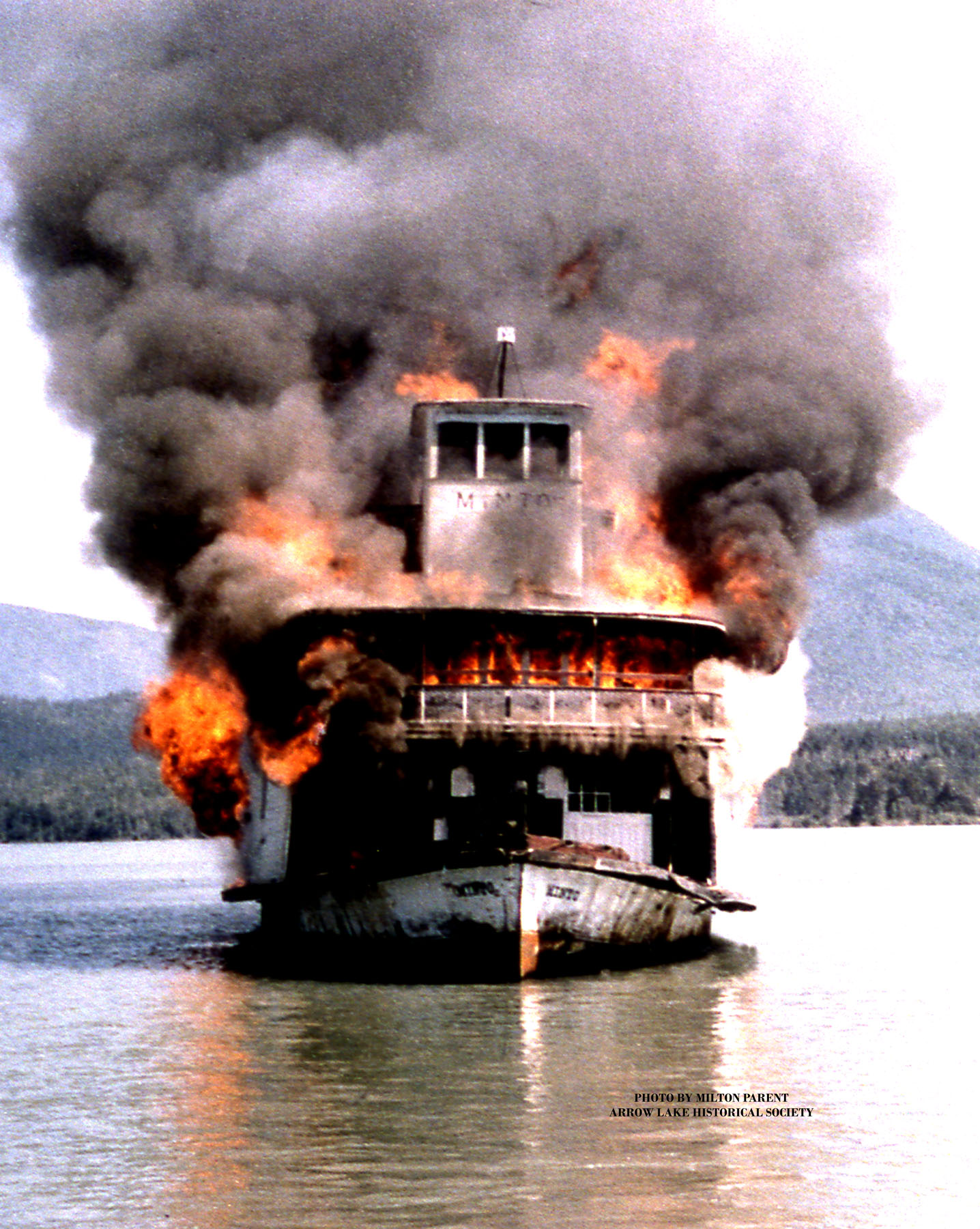
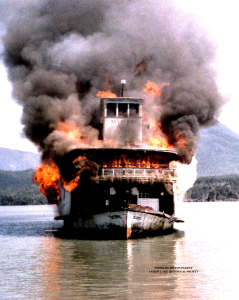
Part I
A couple of summers ago, I stopped at the Needles ferry for a picnic and walked along the shore of Arrow Lake. I was surprised with how little water there was in the lake. I could throw a stone across to Fauquier. I strolled down the steep bank to the waters edge and noticed a bright, oddly shaped stone. When I picked it up I was delighted to have retrieved a perfect arrowhead. The artifact was evidence of a passing native hunter; a man long gone from history. This was the start of my Arrow Lake Saga.
In 1953, the Sinixt People of the Upper Columbia River were declared extinct by the Canadian Government. This came as quite a surprise to the Native people still living on the Canadian side of the river basin. You might ask “why is this important to the powers that be in B.C.?” Well, that would simplify the movement to dam the Arrow Lakes.
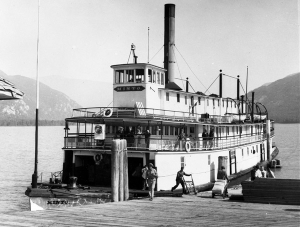 The U.S. had been damming the Columbia since the 1930’s to control flooding and provide power to cities on the Lower Columbia. They constructed the Bonneville and Grand Coulee dams to also assist with navigation to their inland ports.
The U.S. had been damming the Columbia since the 1930’s to control flooding and provide power to cities on the Lower Columbia. They constructed the Bonneville and Grand Coulee dams to also assist with navigation to their inland ports.
This all changed with the destruction of Vanport, Oregon during a flood in 1948. The city, the second largest in Oregon, was completely destroyed with the loss of 15 souls. Vanport was created after the First World War to provide jobs for veterans and their families. It was built on reclaimed river land and surrounded by high dikes.
As happens amongst governments dealing with international concerns, Canada and the U.S.A. decided to study the problem of this shared waterway. After studying for 11 years, the governments came up with a recommendation listing principles of how to negotiate an agreement to put dams on the Columbia. The appropriation of costs and benefits would be an ongoing issue of contention. Formal negotiations began in 1960 after twelve years of continued water problems. These negotiations were not about power (to begin with) but strictly about flood control. The undercurrent of the U.S. negotiators was always about the fact that power could not be generated efficiently without trans-boundary co-operation.
The Treaty was signed January 17th, 1961 by Prime Minister Diefenbaker and President Eisenhower. It was, however, postponed for three years due to the interference of the B.C. Premier, W.A.C. Bennett.
Premier Bennett stood fast with his “show me the money” attitude. His Social Credit Government was committed to the development of “public” power. He demanded funding for his “Two Rivers Policy”, and wanted the Columbia Treaty to include capital for his Peace River power project. He succeeded by passing Bill 5 that created B.C. Hydro as a public corporation. This corporation had no cash to finance these huge projects so Bennett succeeded in negotiating the Canadian Entitlement Fund with the Canadian Government pitching guarantees to the 274.8 million US fund and the U.S. contributing half of their power revenues and half of what the estimated cost of flood damage would be without the dam (64 million US) over 30 years.
Bennett completed both river projects in good time, but the construction and peripheral costs ran far more that the original benefit to the people of B.C. Future BC Governments would call it a shameful sellout.
Before the dams, the Arrow Lakes were a pristine highway between Revelstoke and the CPR mainline; and Castelgar and 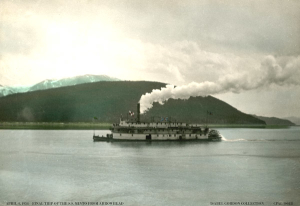 the mines to the south. It was similar to Okanagan Lake in that settlements stayed mostly to the deltas of creeks and rivers along the route.
the mines to the south. It was similar to Okanagan Lake in that settlements stayed mostly to the deltas of creeks and rivers along the route.
Transportation was provided by sternwheelers, eleven of them between 1888 and 1954; and five tugs between 1891 and 1954. As with Okanagan Lake, there were four CPR sternwheelers: the Minto, the Kootenay, the Rossland and the Bonnington. They plied the waters between Arrowhead in the north and Robson West to the south.
The big town on the lakes was Nakusp and this is where CPR decided to put the boat-building business. Nakusp was on the west end of the Slocan and was served by a CPR spur line to the mines of Sandon, New Denver and Silverton. Arrow Lake was dotted with small hamlets along the route, sparsely populated with mostly British colonialists looking for tranquility in an agrarian lifestyle.
Generations lived contently along the lakeshore, off the grid; paying little for self-sufficiency. Similar to the prairie grange, the various communities were close and concerned about the welfare of each other. It was a Walden-like existence that needed little policing. But all good things come to an end.
W.A.C. Bennett’s announcement of his dam project startled the citizens along the lake. He announced that the water would rise 12 metres. There were no plans for public hearings or any input from citizens groups. 2000 people were notified that they would be moved in short order. 3144 properties on Arrow Lake were to be expropriated. 39 properties were to go with the construction of the Duncan reservoir. Many more went with the Mica Dam survey. Bennett’s answer to protest was: “Come work on the dams!” and many did.
BC Hydro sent an army of surveyors and assessors to value the properties; many were sent packing by residents but returned soon after with peace officers to complete the job. Property was appraised without consideration for lifestyle and a wealth that cannot be appraised. Crops, livestock, lumber and even tourism were not considered. Moving a family to a new community where surroundings were unfamiliar, friends were gone and costs were higher; was to destroy a wonderful way of life.
Bennett put huge amounts of money into new communities at Burton, Fauquier and Edgewood where some hauled their homes to higher ground. But over the next four years the population dwindled. Citizens just couldn’t fight the BC Hydro legal machine so they took the money and left.
The han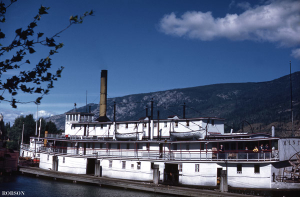 dful of non-extinct Sinixt Nation members held little power with the signing of the water treaty and Indian Affairs refused to address any rehabilitation as there were no reserves or open claims. The timing was perfect and the Tribe lost their sacred sites, their burial grounds and their hunting grounds without so much as a nod. Most moved below the border south of the Libby dam.
dful of non-extinct Sinixt Nation members held little power with the signing of the water treaty and Indian Affairs refused to address any rehabilitation as there were no reserves or open claims. The timing was perfect and the Tribe lost their sacred sites, their burial grounds and their hunting grounds without so much as a nod. Most moved below the border south of the Libby dam.
One casualty of the rising waters was the fate of the S.S. Minto. The little sternwheeler was taken from service in 1954 and purchased by the town of Nakusp as a potential draw for tourists. However, the project floundered for lack of funding and leadership and she was sold in 1956 for scrap. Anything of value was removed but just before total demolition, John Nelson purchased her for $800 and towed her to Galena Bay at the north end of Upper Arrow Lake. He lived and worked on the boat to restore her, but his life ended at 88, ten years after beginning the restoration. BC Hydro assessed the restoration of the boat at over $100,000 so backed away and John’s son, Walter arranged to have the Minto pulled into the middle of the lake for
a Viking funeral. She was burned August 1, 1968.
The Minto was a symbol of life on Arrow Lakes that can never be reclaimed. It falls to memory and to organizations like the Arrow Lake Historical Society and OATS to keep the legends from fading.
The Keenlyside and Mica Dams now produce the majority of the electricity used by the interior of our province. The towns along Arrow Lake have the comforts of this utility like the rest of us and pay like the rest of us. The cost we don’t consider is to the environment, fisheries and paradise lost.
Part II
A year ago the cover story for Archivos was the Viking Funeral of the S.S. Minto. It was the last of the sternwheelers plying Arrow Lake until it was taken out of service in 1954. The part of the story I skimmed over was the efforts of John Nelson of Galena Bay to preserve the remnants of the ship for posterity.
What came to light was an amazing album of photos and notes from a good friend of John Nelson, Isabel Gordon. Isabel and her mother lived in Nakusp most of their lives and loved the Minto. The Nelsons and the Gordons travelled on many occasions together on roundtrips to and fro on the lake. Her photographic record of these trips is a treasure itself and stands as a comprehensive record of the last years of this amazing ship. I want to thank Arnold Talbot, a one-time crew member of the Minto, for finding, preserving and sharing Ms. Gordon’s album with us.
John and Agnes Nelson immigrated from the UK in the late 1900’s and took up farming on the lakeshore just south of Revelstoke at Galena Bay. They and their son Walter, and daughter Margaret, became dependant on the CPR service on the lake. That lake service was the three major sternwheel driven ships, the Bonnington, the Rossland and the Minto. It was much easier to travel to Nakusp to shop for the necessities than to take the train from Arrowhead or the road to Revelstoke.
That’s where they befriended the Widow Gordon and her daughter, Isabel. John became their handyman, helping with chores around their small property that only a man can do. This friendship remained strong for 30 years.
John Nelson loved the Minto. He was a regular on the ship through every season, he knew all aboard and all knew him. Like his ship, he was a fixture on the lake. He would not accept the reality that CPR was not going to continue service indefinitely. The eventuality of the scrapping of the ship and the end of an era came in 1954.
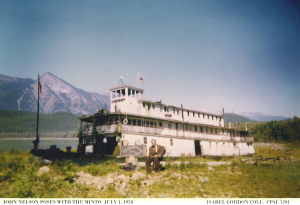 Automobiles and local ferries made the large boats expensive and obsolete. Tugs pushed barges from railhead to railhead north and south on Arrow Lakes. It was just evolution. The other ships had been dismantled many years previous and the Minto was in need of expensive upgrades. Captain Otto Estabrooks had been an admirable pilot and wanted to retire. After all, he had begun as Chief Engineer on the S.S. Okanagan in 1913; that’s nearly 40 years on a sternwheeler.
Automobiles and local ferries made the large boats expensive and obsolete. Tugs pushed barges from railhead to railhead north and south on Arrow Lakes. It was just evolution. The other ships had been dismantled many years previous and the Minto was in need of expensive upgrades. Captain Otto Estabrooks had been an admirable pilot and wanted to retire. After all, he had begun as Chief Engineer on the S.S. Okanagan in 1913; that’s nearly 40 years on a sternwheeler.
Nelson just couldn’t let his lady go and got very involved with the Arrow Lakes Historical Society in an attempt to have the ship declared a provincial heritage site. He was thrilled when the City of Nakusp purchased the vessel from CPR for a dollar as a potential tourist draw. Unfortunately the area was too poor and sparsely populated to seek the financing needed to restore her. After 2 years of attempts to gather funding from the community and government agencies, the Council of the day decided to sell the Minto for scrap. A Nelson scrap company purchased the ship and took every bit of brass and steel out of her (even removing the sternwheel) leaving her empty hulk on the lakeshore at Nakusp.
John stepped in and gave the company his savings of $800 for the rest of the ship. On July 12th, 1956, John’s son Walter towed the wreck using the tug Pentagon, to Galena Bay. She was pushed as close to shore as was possible and as close to the Nelson home as was possible. Then in February of 1957, John’s wife Agnes, died. John was devastated. Driven to complete his project, he moved on board and began repairs. The next season, the lake rose exceptionally high and enabled the Nelsons to drag the ship even further onto the shore. John was able to replace some of the window frames, flag pole and the name-plate but the rest was difficult for a man pushing eighty.
The Minto sat there on the beach for 10 years to the delight of many visitors who were allowed to wander on board and view John’s crude displays of her history. Each year he would throw a Christmas party for his friends and family where he would decorate and light the ship in a seasonal theme.
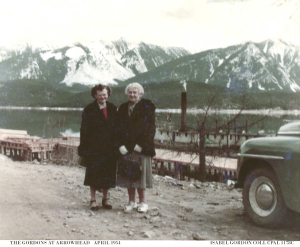 Walter was a big help to his dad and assisted with the ongoing repairs while operating a successful boat rental and guiding business on the lake. Even when John got sick, he helped keep the farm and the ship going. But as all things come to an end, John passed away November 27th, 1967 from complications with pneumonia. He was in his 89th year.
Walter was a big help to his dad and assisted with the ongoing repairs while operating a successful boat rental and guiding business on the lake. Even when John got sick, he helped keep the farm and the ship going. But as all things come to an end, John passed away November 27th, 1967 from complications with pneumonia. He was in his 89th year.
Walter and other members of the Arrow Lake Historical Society pursued BC Hydro for funds to save the vessel but with time running out for the lakeshore with waters rising from the dam; BC Hydro backed out of the deal stating unrealistic costs to preserve an incomplete wreck. Walter had no choice but to haul it out to the middle of the lake and burn it. Even then she didn’t want to go and only burned the superstructure. The rest had to be scuttled.
It’s not known what happened to the Gordons. We assume that the rising waters affected them as well and they moved to a larger centre. Mr. Nelson’s contributions to Isabel Gordon’s scrapbook tells his story and that of the last of the sternwheelers.
